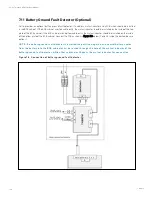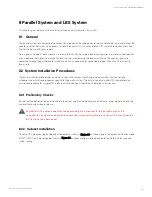
7.5 Battery Installation Environment and Number of Batteries
7.5.1 Installation Environment
Fresh air volume (EN50272-2001)
The operating environment of the battery must be ventilated. During the operation of the battery, the following requirement
for the fresh air ventilation shall be satisfied:
Q=0.05 x n x I
gas
x C
rt
x 10
–3
[m
3
/h]
Where:
Q- The fresh air ventilation volume per hour, the unit is m
3
/h
n- Number of cells
I
gas
- The current producing gas under battery float charging or boost charge conditions, the unit is mA/Ah
I
gas
=1, under the float charging condition of 2.27 V/cell
I
gas
=8, under the boost charge condition of 2.35 V/cell
C
rt
- 20 hr battery rated capacity
Temperature
Typ e
Tem p erature value
Rem ark
Recommended optimal
temperature
20 °C to 25 °C
The ambient temperature for the battery operation shall not be too high or too low. If the
average operating temperature of the battery rises from 25 °C to 35 °C, the service life of the
battery will be reduced by 50%. If the operating temperature of the battery is over 40 °C, the
service life of the battery will be reduced exponentially each day.
Short time allowable
temperature
-15 °C to 45 °C
T able 7.1 R an ge o f am bien t tem peratu re
The higher the temperature is, the shorter the battery service life will be. At low temperature, the charge/discharge
performance of the battery will be significantly reduced.
The battery must be installed in cool and dry environment with the humidity of less than 90%, and be protected from the
heat source and direct sunshine.
The ambient temperature, ventilation, space, float/boost charge voltage, and ripple current will affect the battery
temperature. Uneven temperature among the battery strings will cause uneven voltage distribution and thus result in
problem. Therefore, it is very important to maintain balanced temperature in the battery string, and the temperature
difference between batteries of different layers shall be kept within 3 °C. Valve-regulated battery is very sensitive to the
temperature, therefore the valve-regulated battery shall be used in 15 °C to 25 °C. If the battery cabinet is installed near the
UPS, the maximum design ambient temperature shall be determined according to the battery rather than the UPS. That is,
if valve-regulated battery is used, the indoor ambient temperature shall be 15 °C to 25 °C rather than the operating
temperature range of the main equipment. Under the precondition that the average temperature will not exceed 25 °C, it is
allowed to have short time temperature deviation.
7 Battery
129
Vertiv™ Liebert® APM Plus User Manual
Summary of Contents for APM Plus 0500kMK16FN02000
Page 1: ...Vertiv Liebert APM Plus User Manual 50 500 kVA UPS...
Page 8: ...vi This page intentionally left blank Vertiv Liebert APM Plus User Manual...
Page 34: ...2 Overview 26 This page intentionally left blank Vertiv Liebert APM Plus User Manual...
Page 45: ...Four switches 500 kVA 3 Mechanical Installation 37 Vertiv Liebert APM Plus User Manual...
Page 76: ...Figure 5 11 Customize the display 5 Touch Screen 68 Vertiv Liebert APM Plus User Manual...
Page 86: ...Figure 5 20 Enable module redundancy 5 Touch Screen 78 Vertiv Liebert APM Plus User Manual...
Page 91: ...Figure 5 24 Status Gauge setting options 5 Touch Screen 83 Vertiv Liebert APM Plus User Manual...
Page 92: ...5 Touch Screen 84 Vertiv Liebert APM Plus User Manual...
Page 94: ...5 Touch Screen 86 Vertiv Liebert APM Plus User Manual...
Page 95: ...Figure 5 26 Unit status Bypass details 5 Touch Screen 87 Vertiv Liebert APM Plus User Manual...
Page 96: ...Figure 5 27 Unit status Battery details 5 Touch Screen 88 Vertiv Liebert APM Plus User Manual...
Page 97: ...Figure 5 28 Unit status Load details 5 Touch Screen 89 Vertiv Liebert APM Plus User Manual...
Page 100: ...5 Touch Screen 92 Vertiv Liebert APM Plus User Manual...
Page 112: ...5 Touch Screen 104 This page intentionally left blank Vertiv Liebert APM Plus User Manual...
Page 184: ...12 Specifications 176 This page intentionally left blank Vertiv Liebert APM Plus User Manual...
















































